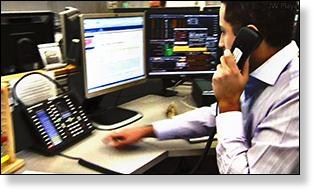
The Trading Desk at the New York Fed Has Speed Dials to Wall Street Firms and Bloomberg Terminals
On any given business day, you can take a taxi ride into lower Manhattan in the wee hours of the morning and see lights and the glow of Bloomberg trading terminals eerily illuminating the 9th floor of the historic Federal Reserve Bank of New York at 33 Liberty Street.
A securities trader working at 4:30 a.m. in any other trading location in Manhattan might be concerned about personal safety. Not here. Quietly, without Congressional hearings, and lost in the tragedy and turmoil of September 11, the USA Patriot Act in 2001
bestowed private domestic policing powers on the 12 Federal Reserve Banks, including the New York Fed.
On top of its own police force armed with Glock 22s and assault weapons, the building itself is a 22-story fortress with 18 floors above ground and four below. The building, completed in 1924, constitutes the block bounded by Maiden Lane, Nassau, Liberty and Williams Streets. The principal architect, Philip Sawyer, was influenced in his design by the Florentine palaces he observed while studying in Italy. The New York Fed's unique façade of large rectangular blocks of limestone and sandstone ashlar with imposing arched windows and ironwork resembles the Strozzi Palazzo in Florence.
There is also the comfort of knowing that if this fortress is safe enough for one of the world's largest stashes of gold, it's likely safe enough for groggy traders. The triple-tiered gold vault rests on a bedrock foundation deep below the building, which not only supports the gold but a 90-ton vault door and 140-ton door frame. The building was built around the gold vault after it was installed.
Karin Kimbrough, the Director of Financial Stability Market Monitoring at the New York Fed, has participated in an educational video to explain what goes on all day in that trading room. According to Kimbrough, the traders take turns coming in at 4:30 a.m. to get a jump on market intelligence by calling their contacts in London, Frankfurt and Japan. Market intelligence is now a top priority for the Markets Group which oversees the trading function at the New York Fed - the only one of the 12 regional Federal Reserve banks to have its own trading floor.
Kimbrough explains what the traders and analysts are looking for in the way of anomalies in markets: "...if there was a fundamental reason to see German Bund yields rising, what would be the consistent view across all asset prices. Are we seeing something similar in other sovereign bond markets? Are we seeing something moving in equity markets? Typically, we also try to think a little bit about the context of these moves. Are they large moves; are they moves that we see daily and really something that we're expecting every morning or every season."
Monitoring equity markets is not something that was heretofore understood to be the purview of the New York Fed or the Federal Reserve System, which functions as the central bank of the United States and is tasked with carrying out monetary policy. But as we
reported last week, for some inexplicable reason, the New York Fed now has its own equity analyst team looking at the stock performance of the biggest banks. (That gives a whole new level of meaning to mission creep.)
Read the rest of the article here.
Reader Comments